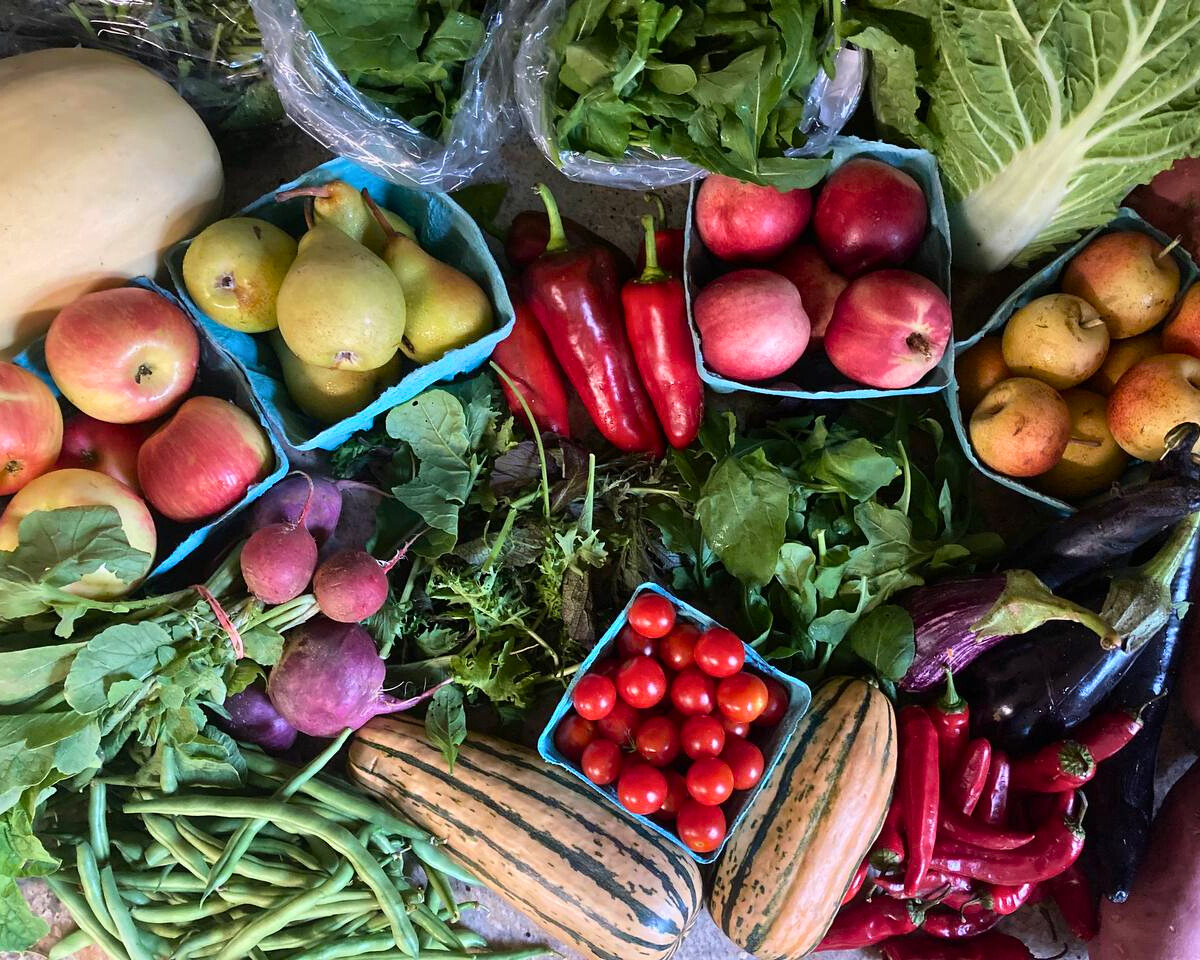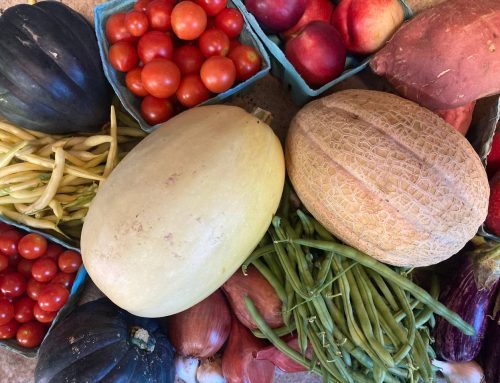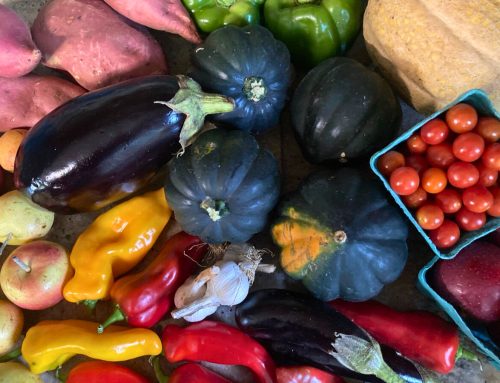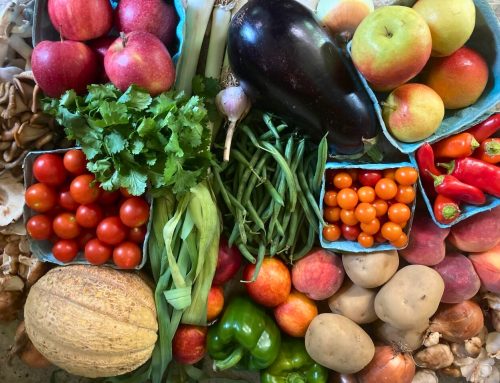Are cocktails just an excuse for sugar and alcohol these days? With all the simple syrups and sweet mixers, it seems we’ve lost sight of their original purpose.
Did you know the pre-dinner drink used to have a much more beneficial role? It wasn’t just about relaxing; it was designed to kickstart your digestive system.
The secret ingredient was something we rarely think about today—bitters! Just like dark leafy greens, bitters help stimulate digestion, making them a powerful addition to your diet.
Speaking of greens, incorporating dark leafy vegetables into your meal prep can have a similar effect.
Whether you’re snacking on fresh kale or tossing spinach into a salad, these nutrient-packed greens not only enhance digestion but also prepare your body for the feast ahead.
Let’s explore how eating leafy greens can be a natural way to boost your health, right from the start of your meal—even while you’re still in the kitchen!
Farm Food Highlights
FRUIT:
 Apples, Gala – This popular apple variety is known for its sweet, mild flavor and crisp texture. Gala apples have thin skin that ranges from yellow to red with subtle striping. They are a good source of vitamin C, antioxidants, and dietary fiber, which supports digestion and heart health. Gala apples can be eaten fresh, sliced into salads, or used in baking, sauces, and smoothies. Stored in the refrigerator, they will stay fresh and crisp for several weeks.
Apples, Gala – This popular apple variety is known for its sweet, mild flavor and crisp texture. Gala apples have thin skin that ranges from yellow to red with subtle striping. They are a good source of vitamin C, antioxidants, and dietary fiber, which supports digestion and heart health. Gala apples can be eaten fresh, sliced into salads, or used in baking, sauces, and smoothies. Stored in the refrigerator, they will stay fresh and crisp for several weeks.
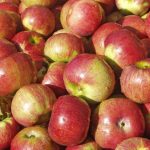 Apples, Cortland – Known for their crisp texture and sweet-tart flavor, Cortland apples are versatile in the kitchen. They have bright red skin with a hint of green and white flesh that resists browning, which makes them ideal for salads and fresh preparations. Cortland apples are low in calories and high in dietary fiber, vitamin C, and antioxidants, supporting heart health and digestion. They are great for eating fresh, baking in pies, or making sauces and cider. Store in the refrigerator to keep them fresh and crisp for several weeks.
Apples, Cortland – Known for their crisp texture and sweet-tart flavor, Cortland apples are versatile in the kitchen. They have bright red skin with a hint of green and white flesh that resists browning, which makes them ideal for salads and fresh preparations. Cortland apples are low in calories and high in dietary fiber, vitamin C, and antioxidants, supporting heart health and digestion. They are great for eating fresh, baking in pies, or making sauces and cider. Store in the refrigerator to keep them fresh and crisp for several weeks.
 Apples, Honeycrisp – Honeycrisp apples are known for their exceptionally crisp texture and balanced sweet-tart flavor. They are low in calories and a great source of dietary fiber, vitamin C, and antioxidants, which support digestive health, boost the immune system, and promote overall wellness. Honeycrisp apples are ideal for eating fresh or adding to salads. Their ability to retain their texture when cooked makes them ideal for cooking and baking. Store in the refrigerator to keep them fresh and crisp for several weeks.
Apples, Honeycrisp – Honeycrisp apples are known for their exceptionally crisp texture and balanced sweet-tart flavor. They are low in calories and a great source of dietary fiber, vitamin C, and antioxidants, which support digestive health, boost the immune system, and promote overall wellness. Honeycrisp apples are ideal for eating fresh or adding to salads. Their ability to retain their texture when cooked makes them ideal for cooking and baking. Store in the refrigerator to keep them fresh and crisp for several weeks.
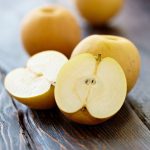 Asian Pears – Also known as “apple pears,” these pears have a crisp apple-like texture but are juicier and less dense. They are rich in dietary fiber, vitamin C, and potassium. These versatile fruits can be enjoyed raw, added to salads, or used in desserts like tarts. Their firm texture holds up well in cooking, making them suitable for baking or sautéing. Store Asian pears at room temperature for a few days or refrigerate them in a perforated bag for up to two weeks, keeping them away from strong odors to preserve their fresh taste.
Asian Pears – Also known as “apple pears,” these pears have a crisp apple-like texture but are juicier and less dense. They are rich in dietary fiber, vitamin C, and potassium. These versatile fruits can be enjoyed raw, added to salads, or used in desserts like tarts. Their firm texture holds up well in cooking, making them suitable for baking or sautéing. Store Asian pears at room temperature for a few days or refrigerate them in a perforated bag for up to two weeks, keeping them away from strong odors to preserve their fresh taste.
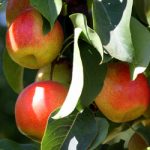 Asian Pears, Reddy Robin – Reddy Robin pears have a striking red skin, sweet, juicy flesh, and a crisp texture. They are rich in dietary fiber, vitamin C, and antioxidants. Enjoy Reddy Robin pears fresh as a snack, sliced into salads, or paired with cheeses. They can also be baked, poached, or used in desserts. Store unripe pears at room temperature until they soften slightly, then refrigerate them to maintain freshness for up to a week.
Asian Pears, Reddy Robin – Reddy Robin pears have a striking red skin, sweet, juicy flesh, and a crisp texture. They are rich in dietary fiber, vitamin C, and antioxidants. Enjoy Reddy Robin pears fresh as a snack, sliced into salads, or paired with cheeses. They can also be baked, poached, or used in desserts. Store unripe pears at room temperature until they soften slightly, then refrigerate them to maintain freshness for up to a week.
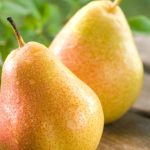 Pears, Sunrise – This yellow-green pear variety is known for its sweet, juicy flesh and smooth texture. They are a great source of dietary fiber, vitamin C, and potassium, which support digestion, immune function, and heart health. Sunrise pears are delicious when eaten fresh, added to salads, or paired with cheeses. They can be baked, poached, or used in desserts like tarts and crumbles. Store unripe pears at room temperature until they soften slightly, then refrigerate to maintain freshness for up to a week.
Pears, Sunrise – This yellow-green pear variety is known for its sweet, juicy flesh and smooth texture. They are a great source of dietary fiber, vitamin C, and potassium, which support digestion, immune function, and heart health. Sunrise pears are delicious when eaten fresh, added to salads, or paired with cheeses. They can be baked, poached, or used in desserts like tarts and crumbles. Store unripe pears at room temperature until they soften slightly, then refrigerate to maintain freshness for up to a week.
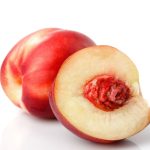
Nectarines, White – White nectarines are smooth-skinned stone fruits with pale, creamy flesh and a sweet, mildly tangy flavor. They are low in calories and rich in vitamins A and C, fiber, and antioxidants, making them beneficial for skin health, immunity, and digestion. White nectarines are delicious eaten fresh, added to salads, or used in desserts like pies and tarts. They can also be grilled or blended into smoothies. Store ripe white nectarines in the refrigerator for up to a week, or leave unripe ones at room temperature to ripen before chilling.
Refer to this post on storage info for your stone fruits: How long do fresh peaches and plums keep?
BREAD: As we move into cooler weather, make sure to have some of our delicious loaves of bread on hand to serve with hearty soups and stews. Our sourdough bread is made with love by Vince right here on the farm.
DAIRY: Delicious sourdough bread needs creamy country butter. If you haven’t already, try the Amish country butter – you are in for a treat!
CHEESE: Several recipes this week call for cheese. Check out our selection of raw milk and grass-fed cheeses, fresh handmade mozzarella, chevre, and more to incorporate into your recipes.
MEAT: If the return of cooler weather and indoor cooking has you thinking about pot roast, add a beef brisket or eye round roast to your market box. Our Willow Haven beef is 100% grass-fed.
PANTRY RECOMMENDATIONS: Dried cranberries are a popular ingredient in fall salads and are a perfect complement to the flavors of winter squash. We have cranberries and a wide variety of other dried fruits to add to salads, granola, grain bowls, and more.
PREPARED FOODS: If you need a ready-to-heat meal solution, check out Chef Dylan’s creations in our Prepared Foods section. Better than takeout!
MEAL SUGGESTIONS:
Celebrate the flavors and colors of fall with this Roasted Delicata Squash Salad recipe. This hearty salad would make a nice lunch or a side for your favorite brisket or roast.
Also try Herbed Baked Greens this week to use your beet greens, mustard greens, or Chinese cabbage. Radish greens would probably work, too!
Skillet Bruschetta with Beans and Greens is another great option for using your mustard or beet greens. Serve as a light but hearty meatless meal. (Add dried beans and farm-made bread to your market box to complete your meal.)
Fresh green beans, shallots, and cashews are steamed in a savory vinaigrette dressing and drizzled with aioli in this Magic Beans recipe shared by farm member Deborah.
Let’s do breakfast (or breakfast for dinner)! Waffles with Squash and Apples is a healthy, hearty meal full of fall spices. (Bonus kitchen tip at the end of the recipe!) Serve with a side of bacon or breakfast sausage.
If you like the combination of winter squash and apples, Apple Squash Casserole is another delicious option.
Skillet Bruschetta with Beans and Greens is another great option for using your mustard or beet greens.
Keep this Stuffed Roasted Winter Squash recipe formula on hand all season. Use it to combine your squash, protein, veggies, and grains or nuts for a creative and highly customizable meal. Bonus points if you have leftovers from another meal to use for the filling! This recipe also multiplies easily if you’re cooking for a crowd.
Organic Veggies We Harvested This Week:
To help you use everything in your box this week, use this Meal Planning Guide to keep track of what’s in the fridge, what needs to be used first, and what you have planned or prepped for each day.
Every member’s customized Market Box is unique so we hope you will take advantage of more varieties of vegetables as you get comfortable with all the great organic produce we are offering. Use our A to Z Vegetable Guide to help use and store your veggies.
Tessa’s Tips
Coming Soon: Butternut Squash. If you want these the first time they are offered, make sure they are rated 5 in your preferences and there aren’t too many other competing 5s.
What to use first: nectarines, pears, arugula, eggplant, microgreens, tomatoes,
Lasts longest: apples, beets, garlic, onions, squash, potatoes, Chinese/Napa cabbage
Finished for the season: asparagus, garlic scapes, rhubarb, scallions, snap peas
Done for now but will return: broccoli, bok choy, collards, kale, kohlrabi
Arugula – This leafy green has a peppery, slightly bitter flavor and is commonly used in salads, sandwiches, and as a garnish. It is low in calories and packed with vitamins A, C, and K, as well as folate and antioxidants, which support eye health, immune function, and bone strength. Arugula can be eaten fresh or lightly wilted in pasta dishes and pizzas. Some prefer to eat it tossed with other fresh greens or lettuce so that the spicy taste is not as strong. Putting it on a sandwich is another delicious way to enjoy its distinct flavor. Here is a collection of recipes for any taste 19 Ways to Eat Arugula. Store wrapped in a paper towel inside a loosely sealed plastic bag in the refrigerator crisper drawer. Properly stored, arugula can stay fresh for up to 3-5 days. For best quality, use arugula soon after purchasing.
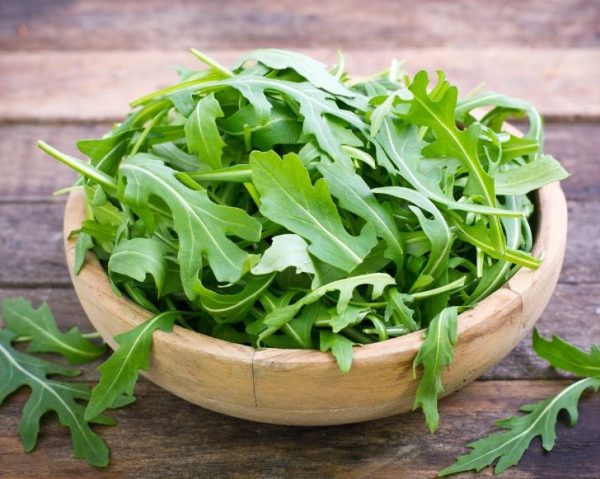
Beans, Green or Yellow – Green beans are not always green. There are yellow and even purple beans! Like all vegetables, green/yellow beans are a nutrition powerhouse. They are a particularly good source of dietary fiber, folate, and vitamins A, C, and K. Beans should be stored in a loosely sealed plastic bag for about a week in the crisper drawer. The yellow beans taste the same as the green and are not “wax” beans. Beans can be used in a variety of dishes. They can be steamed, boiled, sautéed, or roasted and make a great addition to salads, casseroles, and stir-fries. They can also be pickled or blanched and served as a side dish. They pair well with garlic, lemon, herbs, and olive oil. String beans are great with pesto. Use it in this Bean and Potato Salad with Basil Oil. Roasting them is delicious too! Pair green (or yellow) beans with your tomatoes to make this Green Bean Salad with Red Onion and Tomato recipe. See this post for Freezing Fresh Beans.
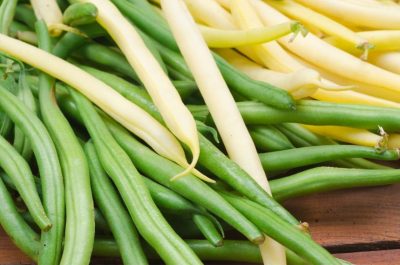
Beets, Red – Red beets are root vegetables known for their earthy flavor and vibrant red-purple color. They are rich in nutrients like folate, manganese, potassium, and dietary fiber, as well as antioxidants such as betalains, which help reduce inflammation and support heart health. Both the roots and greens are edible, with the greens offering additional nutrients like vitamins A and C. Beets can be eaten raw in salads, roasted, boiled, or blended into smoothies and soups. Store beet greens separately from the root, wrapped in a damp cloth or in a plastic bag in the fridge. Use within a few days – they don’t keep long. Beet roots can be stored in a plastic bag in the crisper drawer of the fridge for up to two weeks. To freeze beets for longer storage, slice or chop them, spread on a cookie sheet to flash freeze, then transfer to freezer bags where they can be stored for up to a year. Looking for ways to prepare beets? This post will show you 25 Beet Recipes including beet hummus, a summery borscht, and even a beautifully colored pasta primavera.
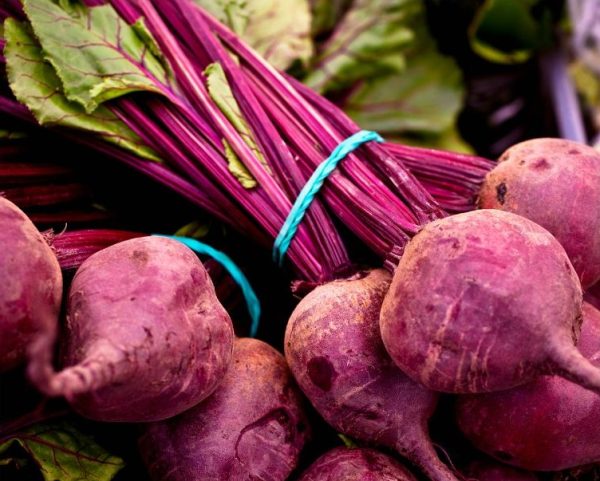
Cabbage, Chinese/Napa – Chinese or Napa cabbage is a pale green, oblong-shaped cabbage with crisp, tender leaves and a mild, slightly sweet flavor. It is low in calories and rich in vitamins C and K, fiber, and antioxidants, which support immune health, bone strength, and digestion. This cabbage can be eaten raw in salads or as a wrap for fillings. It can also be cooked any way you would use traditional cabbage. Napa cabbage tastes excellent in Asian-inspired dishes. It is commonly used in stir-fries, soups, and as the main ingredient in kimchi. Store Napa cabbage in the refrigerator, tightly wrapped, where it can stay fresh for up to two weeks. Stir-fried Chinese Cabbage Recipe is a quick and easy recipe to get you started.
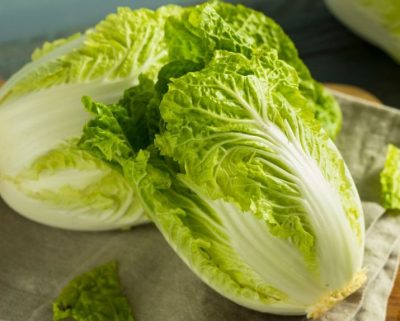
Eggplant, mixed varieties – Eggplant can be left unrefrigerated at a cool room temperature for a day or two or in the crisper drawer for one week but it tastes best when used soon after picking. Eggplant can be peeled or unpeeled depending on the type of dish you are preparing. Just like a zucchini doesn’t have much flavor on its own so it’s often paired with other veggies in a dish, so, too, the eggplant is often paired with other stronger flavors. It can be sauteed, baked, fried, grilled, or steamed. You can freeze eggplant when it is cooked in a dish like ratatouille or baba ganoush, Enjoy the classic eggplant parmesan or pick from these 8 simple ways to cook eggplant.
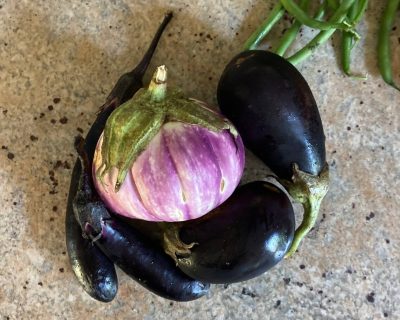
Eggplant, Japanese – Slender varieties of many color variations of purple and white. Lends well to sliced circles.
Eggplant, Purple Globe – Italian globe variety lends itself to stuffing, slicing, cubing, and roasting.
Salting & Draining Eggplant – It’s a good idea, if time allows, to salt the sliced or chopped eggplant and soak in water for about 15 minutes and then gently drain and squeeze to get rid of acrid flavors, according to From Asparagus to Zucchini cookbook.
Garlic – should be kept in a cool, dry place. All our garlic is now cured so it can be stored in a cool, dark, dry place for several months. Use in any recipe and add peeled cloves to pickles.
Microgreens – Transfer to an airtight container or a resealable plastic bag lined with a paper towel to absorb excess moisture. Store the container or bag in the refrigerator’s vegetable crisper drawer, where the microgreens can stay fresh for about 5 to 7 days.
 Mushroom, Portobello & Cremini – These two mushrooms are the same variety but are harvested at different sizes. Store in a paper bag and refrigerate in the main section of the fridge with a dry paper towel to absorb excess moisture. Alternatively, mushrooms can be briefly sautéed or blanched before freezing to extend their shelf life for up to 3 months.
Mushroom, Portobello & Cremini – These two mushrooms are the same variety but are harvested at different sizes. Store in a paper bag and refrigerate in the main section of the fridge with a dry paper towel to absorb excess moisture. Alternatively, mushrooms can be briefly sautéed or blanched before freezing to extend their shelf life for up to 3 months.
 Mushrooms, Oyster – These can be sautéed, grilled, roasted, or added to soups, stews, and stir-fries. Use in pasta dishes, risotto, or as a topping for pizzas. Store in a paper bag in the refrigerator to maintain freshness for up to a week.
Mushrooms, Oyster – These can be sautéed, grilled, roasted, or added to soups, stews, and stir-fries. Use in pasta dishes, risotto, or as a topping for pizzas. Store in a paper bag in the refrigerator to maintain freshness for up to a week.
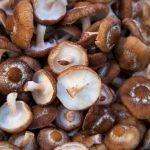 Mushrooms, Shiitake – Add them to stir-fries, risottos, and soups, or use as a filling for tacos. They are also great for Asian-inspired noodle dishes or as a base for stuffed mushrooms. Enjoy their earthy flavor and meaty texture in these and other creative recipes. Store shiitake mushrooms in a paper bag or a loosely wrapped plastic bag in the refrigerator.
Mushrooms, Shiitake – Add them to stir-fries, risottos, and soups, or use as a filling for tacos. They are also great for Asian-inspired noodle dishes or as a base for stuffed mushrooms. Enjoy their earthy flavor and meaty texture in these and other creative recipes. Store shiitake mushrooms in a paper bag or a loosely wrapped plastic bag in the refrigerator.
Mustard Greens – Mustard greens are leafy greens with a peppery, slightly bitter flavor. Rich in vitamins A, C, and K, as well as antioxidants and fiber, they support immune function, bone health, and digestion. Mustard greens are often sautéed, steamed, or added to soups, stir-fries, and salads for a flavorful, nutrient-packed dish. Store fresh mustard greens in the refrigerator, wrapped in a damp paper towel inside a plastic bag, where they can stay fresh for up to a week. For longer storage, they can be blanched and frozen.
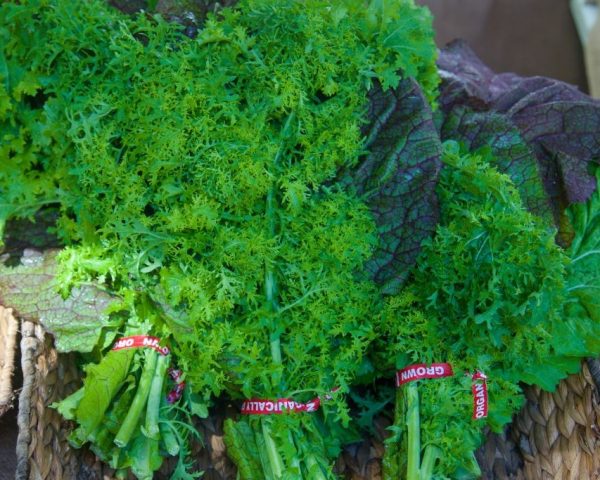
Onions, Sweet Yellow – Sweet yellow onions are known for their mild, sweet flavor and yellowish-brown skin. Their high sugar content makes them ideal for caramelizing and cooking, as they become sweeter when cooked. Pair them with green (or yellow) beans to make Green Beans and Caramelized Onions. They are a good source of vitamin C, fiber, and antioxidants like quercetin, which has anti-inflammatory and immune-boosting properties. Usage: Sweet yellow onions are versatile in the kitchen and can be used raw in salads and sandwiches or cooked in soups, stews, and casseroles. They are especially popular in dishes that require a subtle onion flavor without overwhelming heat, such as French onion soup and onion rings. Storage: Store in a cool, dry, and well-ventilated area away from direct sunlight for up to a month. Avoid refrigerating them, as this can cause them to spoil faster.
Peppers – A popular and versatile vegetable that comes in various colors, including green, red, yellow, orange, and even purple. They belong to the nightshade family and have a mildly sweet flavor and crisp texture. Peppers are low in calories and fat but rich in vitamins and minerals. They are particularly high in vitamin C, providing more than 100% of the recommended daily intake per serving. Peppers also contain vitamin A, vitamin B6, dietary fiber, and antioxidants, such as carotenoids and flavonoids, that contribute to their vibrant colors and potential health benefits.
From L to R: Hungarian wax, jalapeño, cayenne, and sweet colored bell peppers.
Storage for all peppers: Keep them dry and refrigerated in a perforated plastic bag for up to one to two weeks. Avoid storing them with fruits or vegetables that emit ethylene gas, as this can cause them to spoil faster.
IMPORTANT: USE GLOVES! Be cautious when handling hot peppers (at least if you are handling more than a few at a time or are sensitive), as their seeds and membranes contain the most capsaicin and can intensify the heat. Remove these parts if you prefer a milder flavor or keep them for a spicier kick.
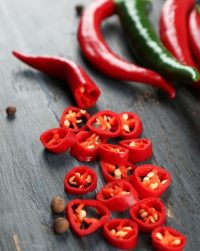
Peppers, Cayenne – Cayenne peppers are long, thin, and vibrant red chili peppers known for their intense heat and spicy flavor. Rich in vitamin C, vitamin A, and capsaicin (which provides the heat), cayenne peppers are commonly used to add spice to dishes. Usage: They can be used fresh, dried, or ground into cayenne powder for seasoning everything from sauces and soups to meat and vegetable dishes. Special Storage: Dry cayenne peppers to preserve for longer periods. Ground cayenne pepper should be kept in an airtight container in a cool, dark place to maintain its potency.
Heat Index: Cayenne peppers typically range from 30,000 to 50,000 Scoville Heat Units (SHU) on the Scoville scale. This puts them in the mid-range of hot peppers, significantly spicier than jalapeños (2,500-8,000 SHU) but milder than habaneros (100,000-350,000 SHU).
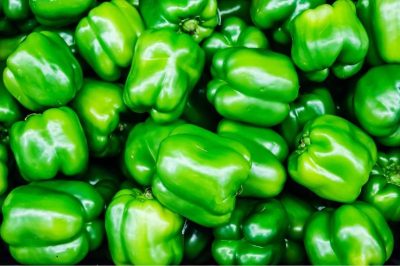 Peppers, Green Bell – Green peppers pack the most nutritious punch when eaten raw. Try on salads, sandwiches, or with a favorite dip. Cooked, green pepper can be used in soups, chili, casseroles, egg dishes, or stir-fries. Can be sliced, diced and frozen for later cooked dishes.
Peppers, Green Bell – Green peppers pack the most nutritious punch when eaten raw. Try on salads, sandwiches, or with a favorite dip. Cooked, green pepper can be used in soups, chili, casseroles, egg dishes, or stir-fries. Can be sliced, diced and frozen for later cooked dishes.
Usage: Peppers can be used raw in salads or as a crunchy snack, and they are excellent for stir-fries, sautés, soups, stuffed dishes, or grilled kebabs, adding flavor and nutrition to various meals. Their different colors can also add an appealing visual touch to your dishes. Try Black Bean & Corn Salad, or Stuffed Tomatoes or Peppers.
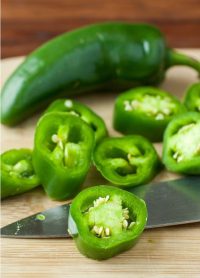 Peppers, Jalapeño – A popular variety of chili peppers with a distinctive bright green or red color when fully ripe. They are low in calories and fat and provide vitamins A and C, potassium, and dietary fiber. They also contain capsaicin, the compound responsible for their spiciness, which is known for its potential health benefits, such as pain relief and metabolism-boosting properties.
Peppers, Jalapeño – A popular variety of chili peppers with a distinctive bright green or red color when fully ripe. They are low in calories and fat and provide vitamins A and C, potassium, and dietary fiber. They also contain capsaicin, the compound responsible for their spiciness, which is known for its potential health benefits, such as pain relief and metabolism-boosting properties.
Usage: Jalapeño peppers are commonly used raw in salsas and guacamole and as a topping for tacos, nachos, pizza, and other dishes. When cooked, jalapeños add a bold kick to soups, stews, sauces, and stir-fries. They can also be roasted, stuffed, or incorporated into marinades for meats and vegetables, offering a depth of flavor and heat.
Heat Index: Jalapeño peppers are known for their moderate to high heat level, typically ranging from 2,500 to 8,000 Scoville Heat Units (SHU). The level of spiciness can vary depending on factors such as ripeness and the specific pepper’s genetics.
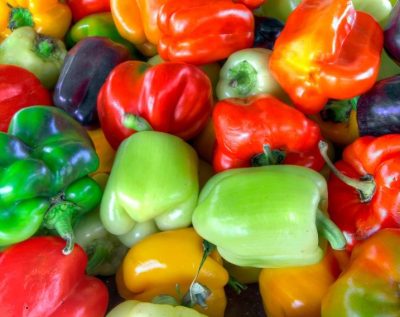
Peppers, Sweet Colored – Also known as bell peppers, sweet peppers come in vibrant colors like red, yellow, and orange. The red variety is the ripest and sweetest. They are rich in vitamins A and C, antioxidants, and dietary fiber, making them a nutritious addition to meals.
Usage: These peppers are versatile and can be eaten raw in salads, sliced for dips, or cooked in a variety of dishes, from stir-fries to stuffed peppers.
Potatoes, Yellow – Also known as Yukon Gold or gold potatoes, yellow potatoes have smooth, thin, yellowish skin and a creamy, buttery-flavored flesh. They are slightly waxy, making them versatile in cooking. Yellow potatoes are a good source of vitamin C, potassium, and fiber alow in calories and fat. Their creamy texture makes them ideal for mashing, roasting, grilling, and boiling. They are also excellent in gratins and salads because they hold shape during cooking. Store yellow potatoes in a cool, dark, and well-ventilated place for several weeks, avoiding refrigeration as it can alter their texture and flavor.
Radish – The roots keep well for up to two weeks in a plastic bag in the fridge. Remove leaves if they are still attached. Store the unwashed greens in a loosely wrapped Debbie Meyer plastic green bag in the crisper bin of your refrigerator and eat them ASAP. Store the radish roots dry and unwashed in a plastic bag in the refrigerator for 1 week. This root vegetable can be eaten raw or steamed for 8-12 minutes for a milder taste. They’re also good on the veggie tray with some dip. Use the greens in Radish Leaf Pesto. Try Roasted Radishes with Chive Vinaigrette or Arugula, Avocado, and Radish Salad with Poached Egg. And if you haven’t tried pickled radishes, they will blow your mind. Use the Fermented Vegetable Recipe included in the DIY Basic Sauerkraut Formula – download to make your own pickled radishes.
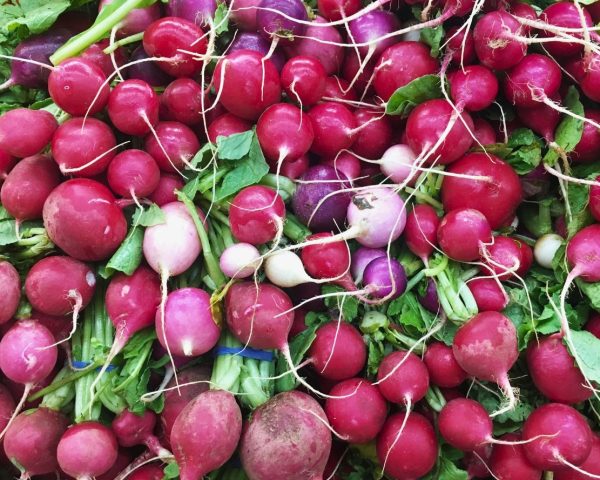
Squash, Delicata – Delicata squash is a small, oblong winter squash with yellow skin and green stripes. It is known for its sweet, creamy flavor and edible skin. It’s a good source of vitamins A and C, potassium, and dietary fiber, which aid in immune function, eye health, and digestion. Delicata squash can be roasted, stuffed, or sautéed and is often enjoyed as a side dish or in salads and soups. Store delicata squash in a cool, dry place for up to a month. Once cut, wrap it in plastic and refrigerate for up to five days.
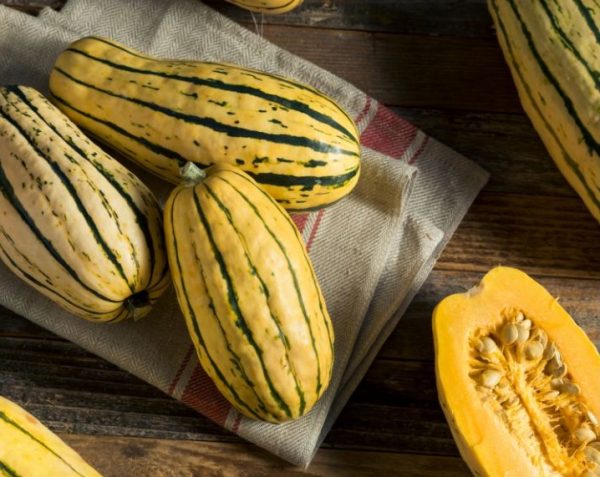
Squash, Spaghetti – Spaghetti squash is a unique winter squash with a mild, slightly sweet flavor and flesh that, when cooked, separates into spaghetti-like strands. It is low in calories and rich in vitamins A, C, and B6, as well as fiber and potassium. Spaghetti squash is often roasted or microwaved and can be used in a variety of dishes, including casseroles, stir-fries, or served with sauces like traditional spaghetti. Store whole spaghetti squash in a cool, dry place for up to a month. Once cut, wrap it in plastic and refrigerate for up to five days.
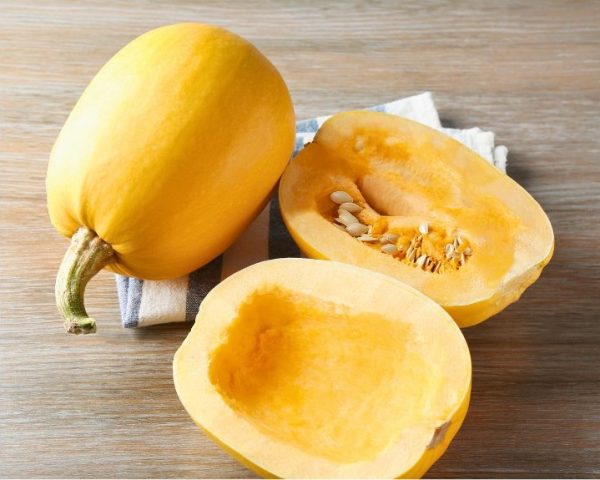
Tip for storing any winter squash: Wipe the skin with vinegar to kill any microbes or spores before storing for longer than a few days.
Sweet Potatoes – Sweet potatoes are a nutritious root vegetable known for their naturally sweet flavor and vibrant orange flesh, though they also come in other colors like purple and white. They are rich in vitamins A (as beta-carotene), C, and B6, as well as dietary fiber, potassium, and antioxidants. These nutrients support eye health, boost immunity, and promote digestive health. Sweet potatoes are versatile in cooking and can be baked, roasted, mashed, or used in soups and stews. They can also be enjoyed in both savory and sweet dishes. Store sweet potatoes in a cool, dark, well-ventilated place for several weeks, avoiding refrigeration as it can affect their texture and flavor. It’s still warm outside, but soup season is on the way. Get ready with this recipe for Sweet Potato Sausage Soup. Sweet potatoes for dessert? Absolutely. Try this Easy Sweet Potato Chocolate Pudding.

Tomatoes, Cherry – Store on the counter; do not refrigerate. Snack or use in salad, frittata or pizza. Whip up this Pasta with Cherry Tomatoes in just 15 minutes for a summery weeknight meal. Make your tomatoes the star of the show in a classic Tomato Bruschetta.
Tomatoes, Medium – This size of tomato is about the size of a golf ball. Use it like a large cherry tomato.
Veggie E-Books
Download these collections of tips and recipes for each veggie. You’ll use these as a reference throughout the season.
Arugula E-Book
Chinese Cabbage E-Book
Beets E-Book
Bell Peppers E-Book
Microgreens E-Book
Mushrooms E-Book
Mustard Greens E-Book
Potatoes E-Book
Radish E-Book
Winter Squash E-Book
Farm Events
Brick Oven Pizza Night
Join us every Friday night from 5:00-9:00 P.M.
Relax and enjoy the farm-to-table flavors
of Massimiliano’s Homestead’s hand-crafted pizza.

As Always…
We support your desire to have a good, healthy way of life and food on your table that supports that goal.
We’ll keep farming for you!
Reuben and Tessa DeMaster
Willow Haven Farm


